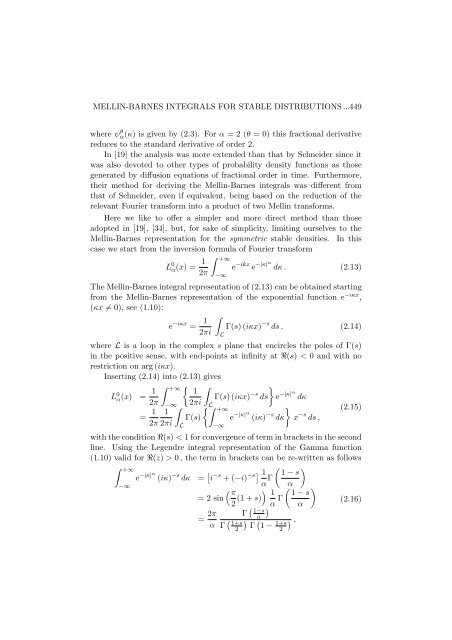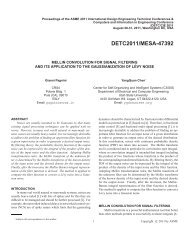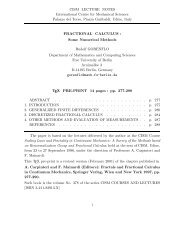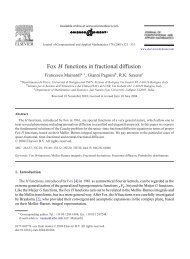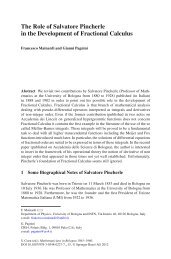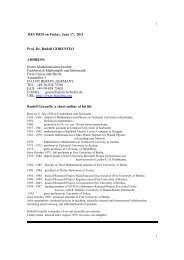MELLIN-BARNES INTEGRALS FOR STABLE DISTRIBUTIONS AND ...
MELLIN-BARNES INTEGRALS FOR STABLE DISTRIBUTIONS AND ...
MELLIN-BARNES INTEGRALS FOR STABLE DISTRIBUTIONS AND ...
Create successful ePaper yourself
Turn your PDF publications into a flip-book with our unique Google optimized e-Paper software.
<strong>MELLIN</strong>-<strong>BARNES</strong> <strong>INTEGRALS</strong> <strong>FOR</strong> <strong>STABLE</strong> <strong>DISTRIBUTIONS</strong> ...449<br />
where ψθ α(κ) is given by (2.3). For α = 2 (θ = 0) this fractional derivative<br />
reduces to the standard derivative of order 2.<br />
In [19] the analysis was more extended than that by Schneider since it<br />
was also devoted to other types of probability density functions as those<br />
generated by diffusion equations of fractional order in time. Furthermore,<br />
their method for deriving the Mellin-Barnes integrals was different from<br />
that of Schneider, even if equivalent, being based on the reduction of the<br />
relevant Fourier transform into a product of two Mellin transforms.<br />
Here we like to offer a simpler and more direct method than those<br />
adopted in [19], [34], but, for sake of simplicity, limiting ourselves to the<br />
Mellin-Barnes representation for the symmetric stable densities. In this<br />
case we start from the inversion formula of Fourier transform<br />
L 0 α(x) = 1<br />
2π<br />
+∞<br />
e<br />
−∞<br />
−ikx e −|κ|α<br />
dκ . (2.13)<br />
The Mellin-Barnes integral representation of (2.13) can be obtained starting<br />
from the Mellin-Barnes representation of the exponential function e−iκx ,<br />
(κx = 0), see (1.10):<br />
e −iκx = 1<br />
2πi<br />
<br />
L<br />
Γ(s) (iκx) −s ds , (2.14)<br />
where L is a loop in the complex s plane that encircles the poles of Γ(s)<br />
in the positive sense, with end-points at infinity at ℜ(s) < 0 and with no<br />
restriction on arg (iκx).<br />
Inserting (2.14) into (2.13) gives<br />
L 0 α(x) = 1<br />
2π<br />
= 1<br />
2π<br />
+∞ <br />
1<br />
<br />
−∞<br />
1<br />
2πi<br />
2πi<br />
Γ(s)<br />
L<br />
Γ(s) (iκx) −s <br />
ds e −|κ|α<br />
dκ<br />
e −|κ|α<br />
(iκ) −s <br />
dκ x −s ds ,<br />
L<br />
+∞<br />
−∞<br />
(2.15)<br />
with the condition ℜ(s) < 1 for convergence of term in brackets in the second<br />
line. Using the Legendre integral representation of the Gamma function<br />
(1.10) valid for ℜ(z) > 0 , the term in brackets can be re-written as follows<br />
+∞<br />
e −|κ|α<br />
(iκ) −s dκ = i −s + (−i) −s 1<br />
<br />
1 − s<br />
−∞<br />
= 2 sin<br />
= 2π<br />
α<br />
α Γ<br />
α<br />
<br />
π<br />
<br />
1<br />
(1 + s)<br />
2 α Γ<br />
<br />
1 − s<br />
α<br />
Γ <br />
1−s<br />
α<br />
Γ <br />
1+s<br />
1+s ,<br />
2 Γ 1 − 2<br />
(2.16)


